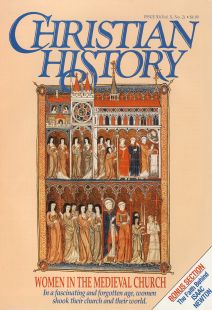Terms of the Religious Life
abbess: the female head, or superior, of an abbey. An abbey may be either a convent or monastery, though more often the word designates a convent. (An abbess’s male counterpart is called an abbot.)
anchoress: a woman who lives a solitary life of silence and prayer, especially one who remains in confined quarters, usually a single small room (or cell). In the later Middle Ages, an anchoress’s quarters (the anchorhold) were often attached to the wall of a church. (This life was also pursued by men, who were called anchorites.)
beguine: a laywoman who belonged to certain sisterhoods that arose in Belgium and the Netherlands in the late eleventh and twelfth centuries. A beguine took no vows, or temporary ones, usually of chastity and simplicity, and devoted herself to good works. Though often living in community, a beguine was free to hold private property and to leave the community and marry. (The male counterparts to the beguines were called beghards.)
cenobite: a member of a religious community (the word is taken from the Greek for common life). The opposite of eremite.
convent: a community of nuns who take vows and live under the direction of a superior. (Historically, the word could refer to a religious community of either men or women.)
eremite: a person who isolates himself or herself from society in order to pursue the religious life. Related terms include recluse, solitary, and hermit.
mendicant order: a group of friars, such as the early Franciscans, that depends upon begging alms.
religious: a member of a religious order. In canon law a religious is a person who lives in community and takes vows of obedience, chastity, and poverty.
tertiary: a member of a Third Order (see next entry).
Third Order: an organization of lay people affiliated with one of the mendicant orders such as the Dominicans or Franciscans. Though living in the world, members of a Third Order try to live lives of sacrifice, simplicity, and service, like the friars (First Order) and sisters (Second Order) of their mendicant order.
By the Editors
[Christian History originally published this article in Christian History Issue #30 in 1991]
Next articles
Life in a Medieval Village
From birth to death, a peasant woman’s difficult life intersected the church.
Frances and Joseph GiesInside the Convent
How did convents arise? Why did so many medieval women enter them?
Jo Ann McNamaraA Skeptic Inside the Nunnery
Spiritual vitality—and tensions—within a twelfth-century priory.
Aelred of RievaulxWomen in the Medieval Church: A Gallery of Christian Women Writers of the Medieval World
Who was who among Christian women writers of the Middle Ages.
Katharina M. WilsonSupport us
Christian History Institute (CHI) is a non-profit Pennsylvania corporation founded in 1982. Your donations support the continuation of this ministry
Donate



